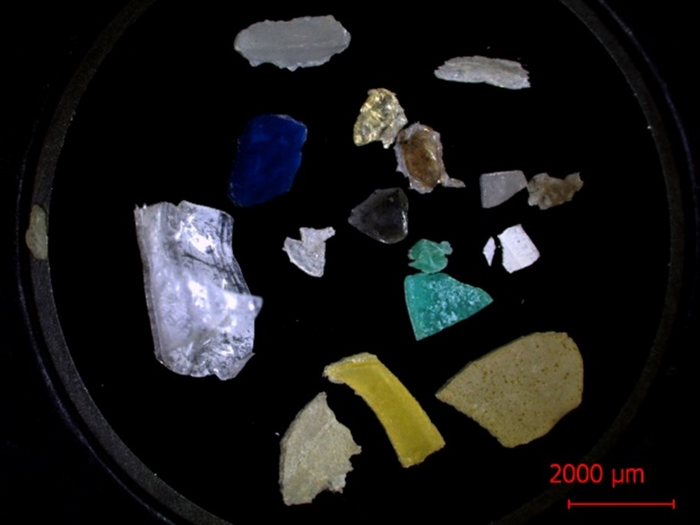Investigators from Kyushu University and Asahi Kasei Corporation have created a new technique to assess the age of microplastics found in the upper oceans. The method involves evaluating plastic oxidation levels in conjunction with environmental parameters like UV exposure and ambient temperature.
 Samples of microplastics. Microplastic samples collected from the oceans. Plastic fragments less than 5 mm in length are categorized as microplastics. The scale bar shows a length of 2000 µm or 2 mm. Image Credit: Kyushu University/Asahi Kasei Corporation.
Samples of microplastics. Microplastic samples collected from the oceans. Plastic fragments less than 5 mm in length are categorized as microplastics. The scale bar shows a length of 2000 µm or 2 mm. Image Credit: Kyushu University/Asahi Kasei Corporation.
The researchers used their new method to assess the age of microplastics discovered nearshore and offshore in the North Pacific Ocean. They discovered that microplastics in nearshore regions ranged in age from 0 to 5 years, whereas microplastics in offshore locations ranged from 1 to 3 years. They published their findings in the journal Marine Pollution Bulletin.
Plastics are the most common pollutant in marine environments ranging from lakes to seas. When plastic garbage is exposed to the environment, it ultimately degrades and fragments. “Microplastics” are plastic waste that has been broken down to less than 5 mm in length.
Microplastic pollution is recognized as a global problem. In a previous study, we found that there are about 24 trillion grains of microplastics floating on the surface layer of the ocean. However, there is still little we know about its effects on the environment or to living creatures. Another big question we have is how long microplastics drift through the ocean.
Atsuhiko Isobe, Professor, Research Institute for Applied Mechanics, Kyushu University
Atsuhiko Isobe headed the research.
To determine how old microplastics present in the ocean can be, Isobe and his colleagues first investigated what measures could be used to evaluate microplastic age.
The most common material in plastic is called polyethylene. We know that as polyethylene interacts with the environment it, oxidizes and degrades. This degradation level can be measured using the change in the material's molecular weight and something called the carbonyl index. Simply, when polyethylene degrades its carbonyl index increases and molecular weight decreases.
Rie Okubo, Study First Author and Researcher, Asahi Kasei Corporation
Obviously, that is insufficient. As microplastics are exposed to the elements, the researchers wanted to standardize how temperature and UV radiation influence plastic decomposition. The researchers first performed a series of polyethylene exposure experiments to collect data on how different combinations of UV and temperature influenced the material's molecular weight and carbonyl index.
The researchers discovered that the two most important drivers of plastic degradation were UVER (ultraviolet erythemal radiation, a measurement of UV radiation at ground level) and seawater temperature.
Once we had this data, we began to apply it to our microplastic samples. All our samples came from the upper ocean, up to one meter from the water surface. We also collected microplastics from a range of areas. Some samples were collected nearshore to Japan, ranging from 10 to 80 km off the coast. Other samples were collected offshore, in the middle of the North Pacific Ocean and Philippine Sea.
Rie Okubo, Study First Author and Researcher, Asahi Kasei Corporation
The researchers were able to determine the age of each induvial sample by analyzing the collected microplastics. They discovered that nearshore microplastics ranged in age from 0 to 5 years, whereas offshore samples ranged in age from 1 to 3 years.
Okubo details, “We hypothesize the reason why nearshore microplastics range from 0 to 5 years is because they are being frequently washed ashore and 'surviving' for a longer time. Offshore microplastics on the other hand take longer to reach that part of the ocean, hence why we didn't find microplastics over 3 years old. These offshore microplastics are also likely removed from the upper oceans by settling deeper into the waters.”
The researchers believe that the new method will provide them with more information about how microplastics are produced and distributed in the environment. The data will also aid in the development of more accurate simulations for tracking microplastics in the ocean.
“Our research and understanding of microplastics is still very new, and thanks to this data we've gained a little more understanding on the fundamental science of microplastics. Our next step will be to investigate how mechanical stimuli like ocean waves and currents can degrade plastics, so we can collect even more accurate data,” concludes Isobe.
Journal Reference:
Okubo, R., et al. (2023). Estimation of the age of polyethylene microplastics collected from oceans: Application to the western North Pacific Ocean. Marine Pollution Bulletin. doi.org/10.1016/j.marpolbul.2023.114951.
Source: https://www.kyushu-u.ac.jp/en